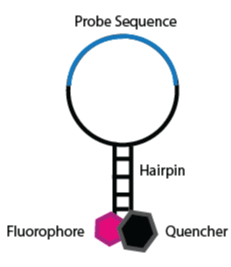
TriLink Expertise: Using Chemistry to Solve Big Biological Questions
February 2016

In his February 9 Zone in with Zon blog post, Jerry explores the scope and diversity of scientific publications citing TriLink products over the past year. As Jerry was pulling together this blog, he found that one of the more popular papers in TriLinks history was a 2001 publication featuring molecular beacons. The research highlighted in Design of a Molecular Beacon DNA Probe with Two Fluorophores by Peng Zhang, Terry Beck (TriLink co-founder and Sr. Vice President) and Weihong Tan helped pave the way for a field that has evolved tremendously over the past 15 years. Given the extraordinary growth of probe-based applications, we thought it would be interesting to revisit the history of the molecular beacon.
Prior to 2001, designs of molecular beacons had a single fluorophore and quencher, located at each end of the hairpin structure (Figure 1). In the closed-stem position, five to seven bases at each end of the probe are complementary, forcing the quencher and fluorophore within proximity, thereby quenching the fluorescence. Upon binding to the target, the structure unfolds to an open-stem formation, which leads to the restoration of fluorescence.

Although molecular beacons were already shown to be highly selective, the sensitivity and dynamic range were not optimal due to residual fluorescence when in the closed-stem form. The clever dual-label design consists of a fluorophore on each end (F1 and F2), specifically chosen to allow for fluorescence resonance energy transfer (FRET) when they are in proximity. Therefore, when the probe is in the closed-stem form and excited at the absorption of F1, the fluorescence of F2 will be observed. When the probe is bound to its target and in open-stem form, FRET is reduced or abolished and the fluorescence of F1 will dominate. This allows for a ratiometric calculation that increases the dynamic range and sensitivity.
The virtually unlimited versatility of new chemistries and new nucleic acid methods have allowed for unprecedented growth for molecular probe applications, as well as other DNA- and RNA-based methods, such as next-generation sequencing. TriLink has expansive knowledge of nucleic acid chemistries and manufacturing which makes us the perfect partner for almost any nucleic acid-based assay.

